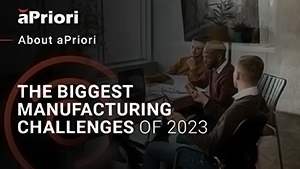LA: We are live at aPriori’s Manufacturing Insights Conference, backstage with aPriori CEO, SF. Stephanie, thank you so much for joining us in the livestream today.
SF: It’s a pleasure. Really excited to be here.
LA: So this year’s theme is making profitability and sustainability a reality for a better tomorrow. Tell me a little bit more about why profitability, why sustainability, why now?
SF: If you look at what’s happened over the last couple of years, even in the last 12 months, there are many new challenges coming at us, whether it’s the impact of supply chain disruptions from the Ukraine war or COVID, profitability issues due to increasing material prices, or inflation, which is really impacting margins and the bottom line. So profitability top focus for all organizations right now.
But coming down the pipeline from different regulatory organizations, sustainability is really moving from the phase of just discussion to intent. What is the manufacturing industry doing to actually have a positive effect on environmental impacts? What do stakeholders need to do to actually act on this and make a difference to reduce the carbon footprint of their product design decisions and their sourcing decisions in the product? How do they incorporate green manufacturing into their company goals?
LA: And in the past, we’ve often heard that profitability and sustainable manufacturing practices move in two different directions. Previously, it was thought that if manufacturers want to maintain profitability, they would have to cut corners on sustainability. Or if they want to focus on sustainability, it’s going to cost a little bit more. Today, as we dive into these customer case studies, we are learning that with aPriori, you don’t have to choose.
Data and Automation Can Drive Sustainable Manufacturing Efforts
SF: Yes. You’re absolutely right. That was the trend historically, because there wasn’t a way to have all of this data coming together. With aPriori, you can make a multifactorial decision with our data from one application. aPriori provides cost feedback, the manufacturability insights that help you ensure that you’re bringing products to market quickly, as well as hitting your cost targets and carbon footprint impact.
The ability to have this data at your fingertips all at one time is astronomical. And not only can you have all the data at one time, but it will enable all the individuals (in real-time) in the product development cycle to be able to act on it. Whether it’s design engineers during the design process, sourcing professionals as they’re working with suppliers and deciding where to make it, what raw materials to use, or the manufacturing organizations behind the scenes. aPriori’s technology provides a competitive advantage to manufacturers who are looking to improve their bottom line, create sustainable products, and get their entire product team on the same page.
LA: This is aPriori’s 10th Insights conference. How do you think the climate has changed over the past 10 years for the manufacturing sector, specifically in regards to digital transformation?
SF: Well, companies have been responding to the different challenges over the past 10 years. The challenge today is that everything is happening faster. Product life cycles are half or less of what they use to be. The time to get products to market are even faster. Their life cycles on market are shorter. And manufacturers are getting feedback from customers even sooner through IoT. Manufacturers need the ability to be able to react and respond to market conditions very quickly. And there’s no way you can do that without having digital information across the whole cycle.
LA: What I’m hearing from our customers at this event is that they want to leverage aPriori software solutions to make profitability and sustainability a reality. They want profitability, and they also want to focus on their carbon footprint. But they don’t know how to make it a reality.
Why Digital Manufacturing Technology is Imperative to Sustainable Manufacturing
SF: One of the things that really makes that possible is what’s at the core of our technology. At the very inside of what we do is, we’ve developed the ability to create digital manufacturing simulations of all the different manufacturing processes that are able to generate those insights for all these different constituents. And it does it fast, in a matter of a few seconds to a few minutes. So that’s the way to make it reality, is to really create that digital manufacturing thread for all of those constituents.
LA: Looking ahead, are you feeling optimistic about what’s facing manufacturers? Are you feeling cautiously hopeful? What are you thinking?
SF: A little bit of both. I think what I’m feeling really optimistic about is that we’re moving out of this phase of tactical actions that we saw deployed during COVID to much more strategic thoughtful initiatives that are driving long-term change so that manufacturers will have the resiliency to not only react to future issues, but that they can flex and accommodate and be able to deal with those future issues as they come.


